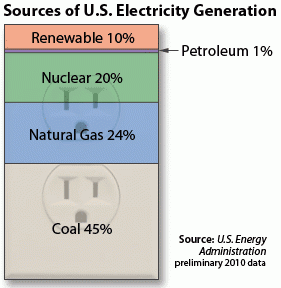Basic Information about Mercury and Air Toxics Standards
Until now there have been no federal standards that require power plants to limit their emissions of toxic air pollutants like mercury, arsenic and metals - despite the availability of proven control technologies, and the more than 20 years since the 1990 Clean Air Act Amendments passed.
 These rules finalize standards to reduce air pollution from coal and oil-fired power plants under sections 111 (new source performance standards) and 112 (toxics program) of the 1990 Clean Air Act amendments.
These rules finalize standards to reduce air pollution from coal and oil-fired power plants under sections 111 (new source performance standards) and 112 (toxics program) of the 1990 Clean Air Act amendments.
- Emissions standards set under the toxics program are federal air pollution limits that individual facilities must meet by a set date. EPA must set emission standards for existing sources in the category that are at least as stringent as the emission reductions achieved by the average of the top 12 percent best controlled sources.
- These rules set technology-based emissions limitation standards for mercury and other toxic air pollutants, reflecting levels achieved by the best-performing sources currently in operation.
- The final rule sets standards for all hazardous air pollutants (HAPs) emitted by coal- and oil-fired electric generating units (EGUs) with a capacity of 25 megawatts or greater.
- All regulated EGUs are considered major under the final rule. EPA did not identify any size, design or engineering distinction between major and area sources.
-
Existing sources generally will have up to 4 years if they need it to comply with MATS.
- This includes the 3 years provided to all sources by the Clean Air Act. EPAs analysis continues to demonstrate that this will be sufficient time for most, if not all, sources to comply.
- Under the Clean Air Act, state permitting authorities can also grant an additional year as needed for technology installation. EPA expects this option to be broadly available.
- EPA issued MATS under a Consent Decree of the D.C. Court of Appeals requiring EPA to issue a proposal by March 16, 2011, and a final rule in December 16, 2011.
- In 2000, after years of study, EPA issued a scientific and legal determination that it was “appropriate and necessary” to control mercury emissions from power plants. The prior administration finalized a rule to cut mercury pollution from power plants, but the D.C. Circuit struck the rule down and required EPA to develop standards that follow the law and the science in order to protect human health and the environment.
